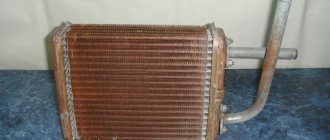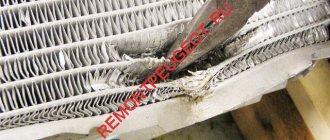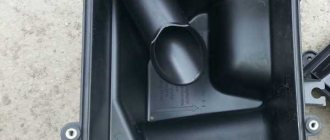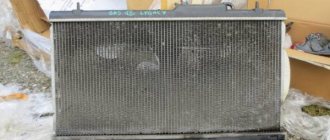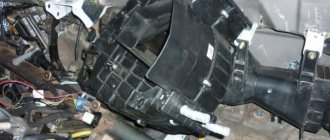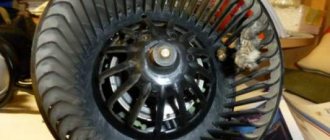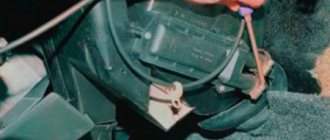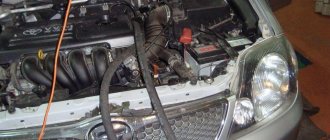Why is the lower radiator hose cold and the upper hose hot?
- 138 6 116k
- 263 5 272k
A hot top and cold bottom of a car radiator is a normal condition only for an unheated engine after starting. If the engine has been running for several minutes, during which the coolant temperature has already reached 80–90 degrees (depending on the model), and the upper radiator pipe is hot and the lower one is cold, this is a sign of a problem in the cooling system.
However, there are exceptions to this rule. The main reasons why the lower radiator hose is cold after warming up are a malfunction of the thermostat or pump , or a clogged radiator . This article will tell you how to determine the specific cause of the problem and what to do in this case.
The engine does not reach operating temperature
You can monitor the temperature readings of the power unit directly from inside the car. The dashboard of all modern cars has a small information field, usually round or semicircular in shape, showing the driver the coolant temperature readings. This is the device that gives an idea of the temperature conditions in which the engine is operating at a given time.
If the temperature gauge does not reach 90 degrees during a long trip, you should seriously think about finding the cause of the deviation from the normal operation of the power unit. It is not recommended to delay its diagnosis, because prolonged operation of the motor in this mode will lead to wear of its internal components.
The fact is that the electronic control unit, which is popularly called the “brains” of the car, recognizes an engine that has not reached the nominal temperature as cold, and therefore the fuel system injects an over-enriched mixture.
Working in this mode leads to heavy carbon deposits on the spark plugs and, accordingly, on the internal elements of the engine, which in the future will lead to the need for a major engine overhaul.
How does the engine warm up?
Each serviceable unit has a different warm-up time. It is influenced by:
- degree of forcing;
- engine type: diesel or gasoline;
- cooling system condition;
- stove operation;
- quality of antifreeze or antifreeze;
- outside air temperature;
- type and viscosity of engine oil.
The characteristics of the oil are rarely taken into account, but experts believe that this is necessary. Various friction reducing additives and the base stock, synthetic or semi-synthetic, affect the performance in the range of 5–7 degrees. Thus, the engine will heat up faster with thinner synthetic oil.
The engine temperature gauge does not rise often due to a malfunction of the thermostat.
It is with this unit that the system check always begins if the engine takes a long time to warm up to operating temperature.
Principle of operation
Coolant enters the radiator through the thermostat. This is a large circle of fluid circulation. The thermostat usually opens at a temperature of 100 degrees Celsius. If the temperature has not reached this limit, then the liquid moves in a small circle. A thermostat malfunction is manifested by improper opening of the valves.
When the thermostat is closed, the engine overheats, and a constantly open one leads to low temperatures, since the liquid will only flow in a large circle.
Due to irregular changes of antifreeze or antifreeze, use of running water or mixing of coolants, various deposits in the form of scale may accumulate in the system. In this case, the thermostat will inevitably jam in one of its positions.
It is important to know
Beginners often make the mistake of believing that the lower pipe should never be cold, and they begin to sound the alarm.
(especially useful during winter): Drive the car into the garage. Let the engine run for 10-20 minutes so that this same pipe has time to heat up, and only then draw your conclusions. The fact is that due to the lack of heat in the cooling system (cold season), the thermostat keeps a large circulation circle closed. If the heater is on, it will prevent the thermostat from opening. Therefore, it must be turned off while the engine is warming up. If after this the lower pipe is cold, there is a problem.
Dirty radiator
The main reason for this, according to most experts, is a clogged radiator
. Over time, this important element of the cooling system becomes clogged with rust residue, dust, leaves and other debris. The location of the radiator is in front of the car. So, no matter what happens, it gets inside. Ultimately, all this leads to problems.
Since this reason is the most important, below is a method on how to clean a radiator. In addition, proper care of the radiator and its regular maintenance ensures the normal operation of the entire cooling system.
Causes of poor coolant circulation
According to the above diagram, the reason that the lower radiator pipe in the VAZ 2110, 2114, 2115 remains cold is the lack of fluid circulation in a large circle of the system. Note that the radiator is the main cooling element. Therefore, the upper pipe through which the liquid enters the heat exchanger will be hotter than the lower one, even if the liquid circulates correctly.
Possible causes of stagnation in the cooling system:
- radiator clogged;
- non-working thermostat;
- airlock;
- pump breakdown.
Any intervention in the engine cooling system requires subsequent flushing of the ODS and replacement of the coolant. Poor quality coolant cannot cope with cooling the engine and can cause a blockage in the system.
Types of pipes and their role in the system
All radiator pipes can be divided into two large groups: - supply pipes; - abductors.
The difference between them is clear from the names. The first type of pipes supplies hot liquid to the radiator. The second type of pipes removes already cooled liquid from the radiator. Of course, the temperature conditions for both types will be different. The former will experience the maximum load, which will lead to the speedy drying of the rubber, and therefore to a speedy replacement of the pipe.
There are also pipes in the cooling system that connect the thermostat to the engine block and radiator. On some car models, the pipes supplying hot liquid to the thermostat may be partially made of metal. The expansion tank is connected to the system using pipes. The simplest circuit contains a pipe connecting the tank to the thermostat, as well as a rubber hose that supplies excess fluid from the radiator to the tank.
Removing the air lock
Signs of the formation of an air lock in the cooling system are rapid warming up of the car to high temperatures and poor performance of the interior heater. This can be especially easy to notice in winter. The reasons for the appearance of an air lock are different:
- incorrect filling of coolant;
- engine overheating;
- depressurization of the system;
- damage to some parts, etc.
If, during the inspection, leakage of antifreeze (antifreeze) is detected in the system, traces of coolant on the engine or other places, the causes of the leak should be eliminated. Often depressurization occurs due to poor tightening of clamps on pipes and hoses. They need to be tightened up. Any deformed or faulty parts found should be replaced.
There are several ways to remove air pockets. The easiest one is to drive up a steep hill with your face up. Unscrew the radiator and expansion tank caps. Let the car warm up for 10-15 minutes. Then release the gas a little and fill the system with coolant to the required level. Continue until bubbles stop appearing.
In VAZ 2110, 2114, 2115 cars, airing is rare. The cause of similar symptoms may be clogged hoses or radiator.
What can be done?
If the car is not warming up well, you can inspect the thermostat yourself.
Checking the functionality of the thermostat
The design of the device implies sensitivity to changes in temperature. The pressure in the coolant system does not affect the restriction of antifreeze circulation through the small circuit, cylinder head and block cooling space. As the temperature difference between the engine and the environment increases, the thermostat gradually opens the coolant supply from the main radiator to the engine.
The same thing happens when the difference in indicators decreases. This process helps maintain and limit the temperature limit of the engine, as well as heat the interior of the car. To determine if the thermostat is working properly, you do not need to remove it.
You can detect a breakdown manually when starting the engine. When it has warmed up for 5 minutes, you can check the device.
Starting will cause coolant to circulate through the engine's cooling passages. Heating of the coolant begins in the engine and radiator of the car. The pipe going in the opposite direction from the radiator to the engine should not be hot. If this happens, then there is a problem with the thermostat.
Removing the air tube
The main reasons for poor heating in winter include air lock. It is useful for a car driver to have the knowledge and skills to remove air from the system. Its accumulation occurs at the highest point - the throttle assembly. From there you need to remove the air plug. The sequence of actions is as follows:
- Unscrew the filling cap on the engine, remove the screen and screw the cap into place to avoid contamination of the crankcase.
- Find 2 pipes, which are located side by side in the throttle assembly, and pull out 1 of them.
- Open the coolant expansion tank and cover it with a clean cloth.
- Blow slowly into the tank until antifreeze flows out of the hose.
- Put the tube back on and tighten the clamp quickly so that no air gets into the pipe.
This scheme is suitable for the VAZ 2114. When clogging of the cooling paths occurs frequently, check the entire system, which may be depressurized. If after these steps the engine temperature does not rise, then you need to look for another source of problems.
Engine insulation
By insulating the engine, you cannot get rid of all problems with warming up. If the engine is properly insulated, it will not require prolonged warming up during the day, and the coolant temperature will be normal. To insulate domestic equipment, heat-insulating material is installed between the radiator and the front grille. The motorist can use cardboard or buy special insulation.
In a purchased product, the padding consists of synthetic insulation covered with a leather substitute. It has the advantage of special holes that open when the temperature rises. Insulation can be achieved by installing a heat insulator under the hood. Special blankets have been developed for this purpose.
You can buy them or make them yourself from felt, mineral wool or other material. This type of thermal insulation helps prevent a layer of ice from freezing on the hood, which often happens in winter when snow falls on the car, melts and freezes. The heat insulator can be glued to the lower engine protection. In the future, it will need to be cleaned of dirt so that it does not get into the engine.
Cooling system hoses are inflated
First things first: Passat car 1995, ADZ engine - 1.8l. How it started: antifreeze began to leak from the gap between the tee (which has a temperature sensor) and the engine. Because it was minus 30-40 outside and there was no desire to climb, I just added antifreeze as needed. I didn’t pay attention to the pipes and others (if there is a leak, you first need to seal it, and only then look further) Now it’s warmer and on Sunday I fixed all the leaks (I found 2 more).
The problem is this: the hoses on the radiator inflate and antifreeze is forced from the expansion tank into. I think the cooling system. What I have already done (except for eliminating the leak): - I made sure that the fan on the radiator is working and it seems that the thermostat in the engine is also alive. I checked it this way: I started the cold engine and checked the temperature of the radiator with my hand. At the beginning, only the top became warmer (the bottom was cold, that is, there was a temperature difference and that meant the thermostat was closed). Using the temperature sensor on the dashboard, I waited for the temperature to be approximately 90 degrees and touched the radiator - it was equally hot from the top and bottom and on the sides - in general, it was hot everywhere. So the thermostat opened. I sat down again and pressed the gas, like warming it up (it’s like minus 10 outside) for about . (but less than 95) degrees the fan turned on and quickly cooled everything down to less than 90. - I tried to expel the air from the stove. I don’t know the technology for passats, so I did it as I once did on the figure eight - I sharply squeezed the lower pipe with my hand (like creating pressure). I tried to drive it out by starting the engine with the cap on the expansion tank open. In general, I don’t know if I kicked it out or not, but the stove heats up like crazy. At the same time I noticed this thing - antifreeze is constantly being released into the reservoir through the upper pipe (thin). I called my mechanic and outlined the problem, but there were no ideas. I read the forum - I really didn’t find anything (except maybe change the cylinder head gasket - maybe gases are breaking into the cooling system. But there is no oil or foreign smell in the coolant.) I’ll take off the spark plugs at lunchtime and see what kind of carbon deposits are on them.) A month ago the changers were black, like rich mixture, but this is understandable - it’s still minus 40, idling for 6-8 hours, starting cold, etc.) In general, I don’t know what to do next :-(((Help with advice.
Methods for expelling air from the VAZ-2115 stove
If a motorist has diagnosed his car and realized that his VAZ-2115 heater is blown, he should use at least one of the methods below, which are considered quite effective solutions to the problem.
First method (blowing out the system)
According to the very first method, the motorist needs to dismantle the plastic casing covering the vehicle’s power unit. To remove this structural element, you will have to unscrew the cap covering the hole for adding oil. Then you need to remove the cover. It is worth noting that immediately after removing the protective casing, the cover should be returned to its place, which will preserve the cleanliness of the power unit by preventing the possibility of dirt and dust from entering.
The next step, which can solve the problem of airiness in the system, should be to search for the pipes responsible for warming up the throttle assembly. At this stage, it is necessary to pull off any pipe and, having twisted the lid from the hole in the container with antifreeze, cover the resulting “hole” with a clean rag.
To get rid of the malfunction, you will have to actively blow out the internal space of the tank. Through such actions, pressure is created, which pushes the collected air out. The need to stop the procedure should be indicated by the antifreeze coming from the pipe, since it will begin to come out only after there are no air accumulations left in the system.
After blowing out the VAZ-2115 system, the tube must be returned to its original place, and you should not hesitate, everything should be done as quickly as possible, otherwise a “portion” of unnecessary air will again appear in the tank.
Second method
If the VAZ-2115 stove is very airy, you can get rid of the resulting plug in just a few minutes without blowing out the system. To expel the accumulation of air, after actively warming up the power unit for 15 minutes, turn it off and, with the expansion tank cap closed, remove any pipe on the throttle assembly. After antifreeze or antifreeze starts coming out, you need to quickly insert the pipe into its original place. However, when using this method, one should not forget that after the power unit was running, the antifreeze could warm up to 80 °C.
Third method
The instructions described below will most likely help anyone whose VAZ-2115 stove is airy. To clean the system, you must first place the car at an angle; for this, a steep hill is suitable; the vehicle should stand with its nose at the highest point. After the car is put on the handbrake, and special stands are installed under all the wheels to protect the driver from unexpected rolling, you need to twist the plugs that close the holes on the radiator and expansion tank.
The power unit must be activated for at least 10 minutes so that it has time to warm up, then you need to press the accelerator pedal periodically, while adding coolant to the system.
Topping up antifreeze or antifreeze should be done until bubbles stop appearing. After they completely disappear, the work can be completed.
Causes of poor coolant circulation
According to the above diagram, the reason that the lower radiator pipe in the VAZ 2110, 2114, 2115 remains cold is the lack of fluid circulation in a large circle of the system. Note that the radiator is the main cooling element. Therefore, the upper pipe through which the liquid enters the heat exchanger will be hotter than the lower one, even if the liquid circulates correctly.
Possible causes of stagnation in the cooling system:
- radiator clogged;
- non-working thermostat;
- airlock;
- pump breakdown.
Any intervention in the engine cooling system requires subsequent flushing of the ODS and replacement of the coolant. Poor quality coolant cannot cope with cooling the engine and can cause a blockage in the system.
Reasons that can cause overheating
1.Lack of coolant. The liquid in the engine boils not because there is not enough of it, but here’s why: remember about the outer surface for cooling? If there is a lack of fluid, the contact surface between the fluid and the heated engine is insufficient, and heat transfer to the environment is poor. This is where the overheating comes from. The engine cooling system is not sealed, as many believe, and fluid evaporates during operation - do not forget to check its level regularly. And of course, monitor the condition of the radiator and pipes - leaks are unacceptable. There are cases of internal leakage - as a result of damage to the gasket between the head and the cylinder block. Water will not flow out of the exhaust pipe, but a constant decrease in the fluid level without visible leaks is a reason to be wary and contact a specialist. Water accumulated in the cylinders at the moment of starting the engine can lead to water hammer - this can literally destroy the piston group, and not only that.
2. Radiator condition. The gaps between the radiator honeycombs are quite small and can gradually become contaminated by representatives of the insect world. This is not a joke; there was a case when minor contamination of the radiator (coupled with the poor condition of the engine) led to constant overheating of the car. Keep the radiator clean and blow it with compressed air at least occasionally.
3. Incorrectly set ignition angle. If the ignition angle is violated, the fuel combustion process is disrupted. As a consequence, an increase in combustion temperature and a decrease in power. The power has dropped, but there is no need. What are we doing? That's right - press the gas pedal harder. It turns out that more fuel is spent on the design operating mode of the engine (at which normal cooling occurs). Hence the overheating. By the way, an ignition problem can arise (spontaneously, and not after your intervention in the finely tuned engine mechanism) if the timing belt or chain is stretched. This is not the only possibility, but it is common - keep in mind.
4. Fuel quality. An inappropriate octane number leads to a decrease in power and an increase in the temperature of fuel combustion. There is only one way out - refuel in one place, so the likelihood of getting bad gasoline is lower.
5. Deposits on the walls of the engine and radiator. The reason is simple - the use of low-quality coolant, or even water. A little more detail. From a physics point of view, using water is better, since water has better thermal conductivity than alcohol-containing antifreeze. But - there are salts in the water (you can see them on the walls of the kettle) - the same thing happens inside the engine. As a result, water circulation is disrupted, cooling efficiency is reduced and the engine overheats. If you are pouring water into the expansion tank, pour distilled water, it is free of salts. It is best to use special antifreeze. Believe me, it is impossible to completely remove scale from the engine. And one more “beauty of water: if, after water, for example in winter, you fill in antifreeze - be prepared for drips (it can leak anywhere: radiator, pipes) - this is a fact. If you constantly drive “on antifreeze,” nothing will happen, but after water, antifreeze will flow 99%.
6. Engine wear. This can include many aspects, but in most cases it is wear of the piston group. During long-term use of the car, the piston rings, which serve to seal the combustion chamber, wear out, which leads to a decrease in compression, impaired fuel combustion, loss of power (remember the formula) and overheating of the car.
The lower radiator hose is cold and the upper hose is hot, what is the reason?
, 05 Dec 2013 17:23
- Page 1 of 7
- 1
- 2
- 3
- Further
- »
- To reply, please log in to the forum first.
#1
- Omega waters
- 72 Posts:
- Gender: Man
- Vehicle characteristics: Opel Omega, 1992, gearbox-5, C20NE (without lambda)
- Name: Alexander
- Donetsk city
Hello everyone, OOA C20NE, my lower radiator pipe is always cold, while the top of the radiator and the pipe itself are hot, what could be the reason? Of course, I understand that this could be a plug or the thermostat is sticking, the lower radiator hose is cold, while on the tidy it’s 100-105 degrees, and when I turn on the heater (it’s blowing hot), the temperature in the cabin drops by 90 degrees throughout) so as not to boil the upper part The radiator is hot, air is expelled. What could this be? I replaced the thermostat, it didn't help! and one more thing I noticed is that there is no pressure in the system! The pipes are all soft, and when you try to unscrew the cap from the expansion tank with the engine turned off, no hissing occurs!
- Top
#2
- Gender: Man
- Vehicle characteristics: Opel Omega B, 1998, manual transmission, X20XEV
- Name: Vladimir
- City: Velikiye Luki
How's the pump doing? Have you tried bleeding the radiator? You can also check the opening thermostat in hot water, maybe it will.
- Top
#3
- Gender: Man
- Vehicle characteristics: Opel Omega, 1992, gearbox-5, C20NE (without lambda)
- Name: Alexander
- Donetsk city
Dirty radiator
The main reason for this, according to most experts, is a clogged radiator
. Over time, this important element of the cooling system becomes clogged with rust residue, dust, leaves and other debris. The location of the radiator is in front of the car. So, no matter what happens, it gets inside. Ultimately, all this leads to problems.
Since this reason is the most important, below is a method on how to clean a radiator. In addition, proper care of the radiator and its regular maintenance ensures the normal operation of the entire cooling system.
Coolant replacement
: Often, when replacing the coolant, beginners make a mistake and then complain about a cold pipe. This concerns a situation where the radiator itself is freed from old fluid, but the tank is forgotten. As a result, this affects the entire cooling system. It starts to act up and diagnostics give no clue.
What to do if the engine overheats
First of all, it should be remembered that if the overheating is short-term (for example, the temperature needle rises in a traffic jam), then you should observe whether the temperature will drop after you start driving (counter air flow appears) or as a result of turning on the radiator fan.
If the car was already in motion and the engine temperature reached a critical level, you should not immediately turn off the engine. Also, you should not try to cool the engine by pouring water on it from outside, pouring cold water into the radiator, etc. Such actions will lead to the need to repair the internal combustion engine, and it may be necessary to change the BC and cylinder head.
Next, you need to wait a few minutes, while simultaneously inspecting for obvious and strong signs of antifreeze/antifreeze leakage under the car or in the engine compartment. If no leaks are visible, but the temperature does not drop, the unit must be turned off.
Please note that you need to immediately turn off the engine when steam starts coming out from under the hood; traces of intense coolant leakage are clearly visible. In this case, the engine must be stopped, without expecting that turning on the stove will reduce the heating.
Let's sum it up
As you can see, there are many reasons for engine overheating, and exceeding the operating temperature itself has a very detrimental effect on the condition of the internal combustion engine. In this case, it happens that the cooling system is clean, the antifreeze level is normal, the fan, pump and thermostat are working normally, but the engine still overheats. In this case, the culprit may be the OZ, since the fuel combustion process is disrupted when the ignition angle is knocked down.
In some cases, the cause of overheating is general wear and tear of the engine and its CPG. Simply put, the piston rings wear out, and insufficient sealing of the combustion chamber leads not only to disruptions in the combustion process of the fuel charge, but also to the breakthrough of hot gases. In this situation, the motor power drops and overheating may occur.
Also, prolonged and heavy load on the engine sometimes leads to overheating. For example, jammed brake pads can make it difficult to roll, causing the driver to actively load the engine. If you add to this the car air conditioner turned on in the heat, the engine will be loaded even more.
Why does the radiator pipe shrink and burst?
One of the dangerous manifestations of a malfunctioning cooling system is a violation of the geometry of the radiator pipes. Why is the situation dangerous if the inlet or outlet pipes of the radiator flatten when the engine has cooled down, and when warmed up they gradually return to their normal state? Why is this happening, can I solve the problem on my own?
About pressure in the cooling system
To effectively remove heat from the engine jacket, liquid cooling systems are hermetically sealed from the environment and can withstand pressure from 1.2 to 2 or more atmospheres. This is necessary to prevent the coolant from boiling when the temperature reaches 100°C. At elevated pressure, various brands of antifreeze and antifreeze can boil when heated to 107°C−120°C, and sometimes 150°C.
Technical means to increase pressure in the cooling system are not used. The required values are achieved due to a natural increase in the volume of heated liquid circulating in the “jacket” of a running engine. Excess pressure is released through the system expansion tank cap, equipped with special valves, in which a certain amount of air is always present.
Bends and cracks in radiator pipes
The excess air released during the expansion of antifreeze or antifreeze in the tank after stopping and cooling the engine is compensated from the atmosphere through the second check valve of the lid. If this does not happen, a vacuum is created in the tank, radiator, connecting pipes and engine jacket. The first to react to this by compression are the least durable elements of the system - the rubber radiator pipes.
The maximum possible value of negative (compared to atmospheric) coolant pressure depends on the temperature difference between the heated and cooled engine. It is no coincidence that motorists notice this problem in winter, when the temperature range is greatest. In this case, the pipes wear out quickly and, having lost their initial elasticity, can burst. The vehicle cannot be operated with such a malfunction.
Expansion tank cap: design features
In addition to the plastic body, threaded part and sealing gasket, the tank lid is equipped with two valves: inlet and outlet. Each of them is designed and must operate under certain conditions. The first opens at excess pressure - for example, 1.2 Bar. The second is needed to compensate for pressure when the antifreeze cools down. If this valve fails, a dangerous level of vacuum is created in the system.
The solution to the problem is to flush the valves or buy a new cap.
The metal parts of the valves may simply be clogged with dirt from the cooling system if it has not been flushed for a long time. In such cases, the problem can be temporarily eliminated by blowing and cleaning the lid valves. If there are repeated failures, you will have to start with a general flush of the entire cooling circuit. If the valve malfunction is due to corrosion of their metal elements, you should purchase a new cover.
How to identify a malfunction
In order to make sure that the radiator pipes are flattened precisely because of the strong vacuum in the cooling system, and the reservoir cap is to blame, it is enough to unscrew the latter a little (only on a cold engine). A characteristic whistle of incoming air will indicate a clogged or rusted check valve. If there is no whistle, you need to flush the entire system. In this case, it is better to start with the upper radiator pipe, which connects it to the expansion tank.
Why buying a new cover may not solve the problem
Unfortunately, the simplest part costing a few rubles does not always meet the requirements. The lid may not function due to a significant difference in pressure at which the valves installed in it open or close. You can check their serviceability and response threshold using a compressor for inflating tires, and adjust it by reducing the number of turns of the corresponding spring. Or simply buy and install a cover from another manufacturer.
Cleaning or replacing the radiator
The radiator, located in the front of the car, absorbs the main flow of dust and dirt. For its effective operation, timely prevention and cleaning is necessary. The radiator can become dirty both inside and outside.
An indicator of internal cleanliness is the condition of the coolant. Manufacturers recommend changing antifreeze every 75,000 km or every 5 years. However, a change in the color of the liquid, severe darkening, discoloration, or the presence of rust requires urgent replacement of the coolant. It is recommended to change antifreeze at least every 40,000 km.
To carry out internal cleaning of the cooling system of VAZ 2110, 2114, 2115, it is necessary to drain the liquid. Sequencing:
- open the expansion tank cap;
- place a container to drain the antifreeze;
- Unscrew the drain plug from the cylinder block;
- drain the refrigerant;
- unscrew the radiator drain plug (located at the lowest point);
- drain the remaining antifreeze (antifreeze);
- tighten all the plugs.
To clean, pour distilled water into the system and start the engine for about 20 minutes. Ordinary water contains many impurities and forms scale, so its use is undesirable. The liquid is drained several times until clean water flows out. This method is ineffective as it removes a small amount of deposits.
For more effective washing, it is advisable to use special chemical additives. The detergent components included in their composition allow you to dissolve deposits and remove various types of contaminants. The mixture of water and vinegar used by many motorists is less effective. It does not remove all deposits. After using chemicals, the cooling system is washed with distillate.
After cleaning the entire SOD of the VAZ 2110, 2114, 2115, an additional internal flushing of the radiator is carried out. To do this, you need to detach the hoses from the base and the upper and upper tank. Liquid is poured into the radiator through the upper pipe using a garden hose. Flushing is carried out until clean water flows from the lower pipe.
The removed radiator can be externally cleaned to remove dirt, insects, and sand from the cooler honeycomb. Cleaning is carried out with a soap solution or special devices that create a strong flow of water or air, for example a Karcher vacuum cleaner. The procedure should be carried out carefully so as not to bend the radiator honeycombs.
If damaged or heavily soiled, the radiator should be replaced.
Replacing the thermostat
If the thermostat valve does not operate correctly, the coolant does not circulate throughout the large circle of the ODS. The lower pipe remains cold even after the refrigerant is heated to 90°C. The top pipe may be hot due to steam escaping. The thermostat can also get stuck in the open position; in this case, the engine does not warm up to the required temperature or takes too long to warm up.
In preparation for replacing the device, it is necessary to drain the fluid from the system and remove the air filter. Then the radiator and fluid pump hoses are disconnected from the thermostat housing. After this, loosen the mounting bolts and remove the thermostat cover. The device is replaced with a working one. Attaching the thermostat is done in the reverse order.
These are the main reasons for the malfunction of the cooling system and the cold lower pipe of VAZ 2110, 2114, 2115 cars.
Thermostat for dummies - logbook Peugeot 308 Sport Back 2009 on DRIVE2
Anyone whose car doesn't heat up well and who has a problem with the thermostat is here for everyone. All the information in one place + express test of your thermostat.
I finally figured out how the thermostat should work correctly. The cornerstone in understanding the work was one trick, but more on that below. First, a little theory. All modern thermostats work on the same principle:
Engine cooling system diagram. top) small circle of circulation, bottom) large circle of circulation
1 - radiator; 2 — pipe for coolant circulation; 3 - expansion tank; 4 — thermostat; 5 - water pump; 6 — cylinder block cooling jacket; 7 — cooling jacket of the block head; 8 — heater radiator with electric fan; 9 — heater radiator valve; 10 — plug for draining coolant from the block; 11 — plug for draining coolant from the radiator; 12 - fan
The small circle performs the function of heating the engine. Those. After a cold start, the liquid begins to circulate in a small circle, only through the radiator of the interior heater. Each thermostat has its own large circle opening temperature. Approximately 90oC +/-. After heating to this temperature, the thermostat opens a large circle and the liquid begins to circulate in a large circle and cools in the engine radiator.
It is very simple to check the correct operation of the thermostat. Just look at how the coolant supply and outlet pipes of the engine radiator and the radiator itself heat up. Warm up the engine to approximately 70°C.
The top pipe should be warm and the bottom pipe should be cold. The radiator itself should also be cold (perhaps a little warm on top).
So, what is this cornerstone in understanding the operation of a thermostat? The large circle opening valve is located in the thermostat on the coolant outlet line from the engine radiator, and not before the supply, as one might logically assume. In theory, if you don’t need to supply coolant to the large circle, close the inlet. But no - the 308s have a closed exit))) I don’t know about other cars...
After the engine has reached a temperature of approximately 90°C, the thermostat opens (the outlet opens) and hot liquid begins to circulate through the engine radiator. Accordingly, the radiator and the lower hose from the radiator warm up. The top one will always be a little hotter than the bottom one.
Why does the upper pipe heat up after a cold start? The liquid that circulates in a small circle heats the liquid that is still standing in the radiator without moving. By regular mixing, because The entrance to the great circle is always open.
What problems could there be with the thermostat:
1. Stuck in open position. The coolant always flows in a large circle. In this case, at subzero temperatures the engine will take longer to warm up. While driving, especially at high speeds and at low engine speeds, the coolant temperature will drop. Example: We warmed up the car to 70 degrees. Go. We went out onto the highway. Engine temperature does not rise or drop. It turns out that the liquid is always cooled on the engine radiator. The thermostat cannot close the large circle when needed.
2. Stuck in the closed position. No liquid flows through the engine radiator. The engine will overheat. Most likely there will be an error in the bookmaker. The fan in front of the radiator will often turn on and run at the lowest speeds.
3. Stuck in the middle position. It will be something between 1 and 2.
4. It does not close completely. It is not jammed. It works, i.e. Opens a large outline. But he can’t close down completely. There are no errors in BC. This is my situation. Perhaps there are deposits in the thermostat, preventing it from closing or something else, I don’t know. But it works like this: after a cold start, the upper pipe, the radiator from top to bottom, and the lower pipe begin to gradually warm up. Those. Some of the liquid circulates in a large circle (the thermostat is slightly open), some in a small circle. By 70 degrees both pipes and the radiator are hot. Hence we have a longer engine warm-up. It's 70 degrees, let's go. If it’s cold outside and especially a headwind, the road is clear - you can drive for a very long time without warming up to 90. This part of the liquid that travels along the large circuit is cooled and merges with the rest of the liquid. Warming up faster in traffic jams. The engine radiator provides less cooling.
Now with a slight plus. The car warms up faster. It also reaches 90 faster. Perhaps there is simply a small gap in the large circle that remains when closed. If it were big, it definitely wouldn’t get warm.
Bottom line: I will change the thermostat. I already have it, I just need to choose the time. Dorestayl manual transmission 1336Z8
Dorestayl automatic transmission 1336Z6
I hope this post will help many. Especially the owners of pego-like ones. The thermostat is a known problem.
Special thanks to Gamodrilla - opened my eyes to the truth. And to everyone who took part in the discussion in the previous two parts about the thermostat))
Everyone +1 to knowledge. And thank you to me)))
